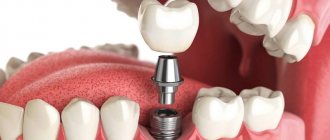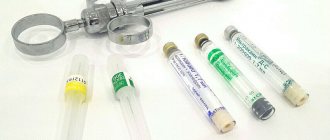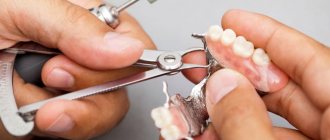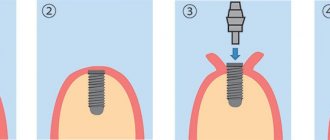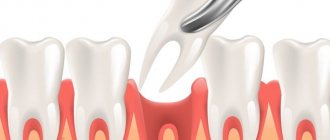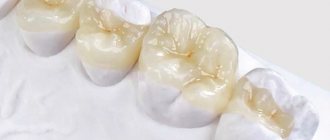The one-stage technique mainly includes one-stage implantation protocols with immediate loading, but in some situations, simultaneously with tooth extraction, a classic implant can also be installed using a two-stage technology. According to many clinical studies, it is one-stage implants installed in the socket of an extracted tooth that protect bone tissue from atrophy and can reduce treatment time with a guaranteed high long-term result of up to 96%1.
Indications
- teeth to be removed are rotten, mobile, destroyed by carious processes,
- single restorations,
- multiple restorations,
- tooth injury,
- simultaneous tooth extraction and implant installation.
Contraindications
- emergency tooth extraction when it is not possible to prepare for implantation,
- complex tooth extraction,
- general contraindications to implantation and surgery.
Advantages of the method
The advantages of immediate implantation are directly related to the ability to place an implant immediately after tooth extraction on the same day
- New tooth immediately Reduces treatment time, no need to wait for bone tissue restoration after tooth extraction
- One operation No need for repeated surgery to access the bone and form a bed for the implant
- Economical No need for expensive bone grafting - no loss of bone, as with a long absence of a tooth
- Aesthetically, the natural architecture of all tissues, the alveolar process and the gingival contour is preserved
Implantation immediately after tooth extraction is the best thing that can happen for the patient.
No time is needed for bone restoration or additional operations. In suitable clinical conditions, a crown can be installed immediately; the person receives a new tooth to replace the extracted one on the day of the visit .
Levin Dmitry Valerievich Chief physician and founder of the Doctor Levin center
Implantation after 6 or more months
Late implantation is rarely required. In the vast majority of cases, the implantation of an artificial root is carried out within a period of up to 6 months.
But there is also a category of patients who are forced to wait more than six months. This is due to the processes of alveolar process atrophy (loss of jaw bone).
In this case, osteoplasty procedures are performed to increase bone tissue to the required volume.
Closed and open sinus lift
This operation allows you to increase the volume of bone tissue in the upper jaw. Before the procedure, a thorough examination of the location of the maxillary sinuses is required. For minor atrophy, a closed type operation is performed; for moderate and critical resorption, an open type sinus lift is performed.
The essence of the operations:
the bottom of the maxillary sinuses is raised and the resulting space is filled with bone material.
When can an implant be installed:
in 2-6 months.
Guided tissue regeneration
Used for the lower jaw. To stimulate the development of bone tissue, special biomembranes and osteoplastic material are used.
The essence of the operation:
An incision is made in the gum, and bone-forming material is added at the site of the deficiency. The gum is sutured until the bone materials are completely integrated.
When can an implant be installed:
in 2-6 months.
Indications and restrictions
Single-stage implantation is suitable when it is necessary to remove mobile teeth destroyed by caries or as a result of trauma. It is used in protocols for single restorations, multiple and complete restoration of teeth.
But for implantation with a guarantee, the following conditions must be met:
- Preliminary planning and diagnostics are required. For emergency removals without examination, the technique is not used, since it is not possible to assess the conditions of a one-time installation.
- There should be no inflammatory processes on the roots of the teeth. If cysts or granulomas are detected, immediate implantation is not suitable. Installation of a sterile implant into purulent bone is fraught with complications.
- Tooth extraction must be atraumatic. For reliable fixation of the implant, it is important to preserve the alveolar process and bone walls and not damage them during removal.
- There should be no general contraindications. If obstacles to surgical intervention are detected, the health condition must first be adjusted.
What happens if you don't restore a tooth?
While eating, the load is evenly distributed over the entire upper and lower row and is transferred to the bone tissue. This stimulates its trophism, ensures normal density, as well as reliable fixation of natural roots.
Single or multiple defects in a row lead to the fact that certain areas of the jaw remain without load. The slowdown in trophism provokes gradual resorption of the bone. It loses volume and becomes less dense.
Compensatory mechanisms ensure the displacement of the remaining teeth. The chewing load is distributed unevenly, which leads to protrusion and accelerated wear of the antagonists. The units move towards the defect where the bone is less dense. Due to the weakening of the ligamentous apparatus, they become mobile.
The visible results of these processes are bite defects, enamel abrasion, and changes in facial contours. Functional inferiority of a number, as well as problems with chewing food lead to chronic gastrointestinal diseases. The severity of the described changes depends on the length of life without teeth.
Atrophic processes are irreversible. It is impossible to slow them down with removable dentures. Only implantation can stop the loss of spongy bone, since it restores trophic processes in the jaw.
Branded rehabilitation - for quick recovery
A unique complex of accelerated rehabilitation
- Lymphatic drainage. Biostimulants improve lymph outflow, prevent the formation of edema and hematomas, tighten the facial contour
- PRP plasma lifting. Platelet-rich blood plasma heals, stops the appearance of hematomas, and reduces swelling
- Microcurrent therapy. Low frequency currents relieve facial microspasms and pain, improve metabolism and healing
More details
We work exclusively with premium implants from the leading company Nobel Biocare®. The line of implantation systems allows you to select the necessary implant in any clinical situation, including simultaneous implantation after the removal of anterior or chewing teeth. We provide a lifetime warranty for implantation together with the manufacturer.
Features of preparation for surgery
The preparatory stage is mandatory to identify contraindications, possible obstacles to implantation and eliminate risks
- X-ray diagnostics A targeted X-ray is carried out (determines the condition of 1-3 teeth) and computed tomography (reveals hidden problems - cyst, granuloma, periodontitis, inflammation at the root).
- Sanitation of the oral cavity is necessary to create sterility in the oral cavity to avoid infection of the surgical wound. If there is dense plaque and stone, hygienic cleaning is carried out. Neighboring teeth are treated for caries.
- Tests are prescribed to patients with general somatic diseases to identify factors that impede surgery. If obstacles are detected, the health status is adjusted by a specialized specialist.
Thanks to clear planning and adherence to protocol, the operation has a predictable outcome
Medium-term implant installation
If it is impossible to apply one-stage technology, the dentist recommends delayed installation to the patient. The waiting period averages 10–20 weeks. During this time, the tissue of the socket heals, the jawbone is restored, and if inflammation is present, it can be stopped.
If the time interval between tooth extraction and implantation is too long, there is a risk of developing atrophic processes in the bone, which can interfere with the normal installation of the artificial root. Therefore, it is not recommended to postpone this operation for more than six months.
Stages of one-stage implantation
The operation is performed under local anesthesia or sedation and lasts no longer than half an hour.
- Tooth extraction is performed using an ultrasonic scalpel according to the PiezoSurgery® protocol extremely carefully so as not to damage the alveolar ridge.
- Implant installation It is installed in place of the extracted tooth. If the hole is wider than the diameter of the implant, bone chips are added.
- Prosthetics In certain conditions, immediate loading with a temporary crown on the day of implantation is possible.
Operations in our Center are performed only by maxillofacial surgeons and implantologists with continuous experience of at least 5 years . These are thoughtful specialists with sufficient theoretical and practical skills, excellent clinical thinking and refined manual skills.
After the operation, we provide a free set of medications to relieve pain and prevent inflammation. The package also contains instructions with rules of conduct during the rehabilitation period. Please do not skip taking medications and follow the recommendations to avoid complications.
BozhkovRoman Andreevich
Implant surgeon, 13 years of experience
Nobel Biocare® Certified Specialist
Leading specialist of the Center for high-complexity implantation. Gently removes teeth using ultrasound according to the PiezoSurgery® protocol. Nobel Biocare® Clinical Expert.
More about the doctor
Possibilities of prosthetics
Depending on the clinical situation, various options for orthopedic structures and the timing of their installation are possible.
For single restorations
- Immediate loading Suitable for single-rooted anterior teeth to disguise the work performed. A temporary plastic crown is made in length slightly shorter than the adjacent teeth in the row, so as not to create excessive pressure to avoid displacement of the still unstable implant. 2-4 months after engraftment it changes to a permanent one made of zirconium dioxide.
- Delayed loading Used for lateral teeth that bear active chewing load and a crown cannot be placed immediately. A gum former is installed on the implant (if one-step bone tissue augmentation was not carried out) or it is tightly sutured with the gum until implantation. For this period, a temporary immediate prosthesis is made, which will not create any pressure on the implant. After fusion with the bone, a permanent crown is fixed.
Whatever option the doctor chooses in accordance with your clinical situation, you will never leave our Center without teeth on the day of implantation. With full implantation
As part of full rehabilitation, several implants are installed on the entire jaw. Some of them can be installed in the sockets of teeth to be removed. A temporary prosthesis is immediately fixed, which unites all the implants into one system and prevents them from loosening, thereby improving engraftment.
After six months, the temporary adaptation prosthesis is changed to a permanent one according to the selected protocol for complete prosthetics - a prosthesis on a beam, a bridge with zirconium crowns on 6 implants, or a segmental prosthesis on 8 implants.
Is it possible to place an implant immediately after removal?
At the first stage, the patient visits the clinic for diagnostics. The blood is submitted to a laboratory for analysis, which can take from one to several days. If you have your own diagnostic unit, the results can be known in a few hours. Afterwards an X-ray examination is carried out. To assess the condition of the jaw, a panoramic X-ray or computed tomography of the jaw is taken and recorded on an information medium. If the patient goes to a third-party clinic or specialized center, the computed tomography scan is issued on a disk with the seal of the medical institution, signature and transcript of the specialist. Printing on film is rarely done, since the recording is more informative for the doctor. At the first appointment, the patient and dentist, having all the necessary data, discuss what result the patient expects to receive and which implantation options are most suitable. If no contraindications are identified during the examination, and a treatment plan is drawn up that meets the patient’s wishes, then the dentist proceeds to the preparation stage.
In order for dental implantation to be successful immediately after removal, the dentist uses a computer model to predict the outcome of the operation. On the appointed day, the patient’s tooth is removed under anesthesia. An implant is placed in the socket, powdered bone material is added if necessary, and sutures are placed to close the operated area and stabilize the implant.
It is impossible to put a full load on an artificial tooth immediately after implantation, since primary stability can be disrupted. It is recommended not to overheat, hypothermia or physically overexert in the first week after surgery. In the first two months, it is recommended to follow a diet. Eat foods rich in vitamins and minerals, not spicy, salty or sour, as such foods irritate the mucous membrane.
The engraftment process takes from 4 to 6 months. After this time, the dentist will schedule a visit to determine the condition of the implant. When healing is complete, the crown is replaced. If the immediate loading technique was used, then initially a plastic crown is installed on the implant. This material is lighter and more aesthetic, and does not load the implant. But after six months of wearing it, it must be changed to ceramics, metal ceramics or zirconium. If a delayed loading protocol is used, a permanent crown is placed. It is fixed to the implant using an abutment after engraftment. The orthopedic stage completes the implantation process, after which the patient can chew and eat familiar foods.
After all procedures are completed, the patient must visit the dentist twice a year. This is necessary to preserve the implant and maintain stable oral health. During preventive examinations, the patient is recommended to undergo a hygienic teeth cleaning procedure. The plaque that forms in the oral cavity cannot be cleaned with a regular brush, even if all hygiene rules are followed. Professional cleaning helps prevent the accumulation of hard plaque around the implant, removes the yellow bacterial film, makes teeth naturally white, and eliminates microbes that cause gum inflammation. Gum disease directly affects the condition of the implant; in weakened gums, it becomes loose and falls out. Ultrasound cleaning reduces the risk of developing any periodontal diseases and improves the condition of teeth and gums.
Lifetime Warranty
We have created all the conditions to exclude medical and technological errors, so without fear we provide a lifetime guarantee for implantation
We work with the best premium implants from the leading company Nobel Biocare®, for which, together with the manufacturer, we provide an indefinite guarantee in the Dr.Levin LifeTime Warranty format . For each installed implant, a passport with a number and series is issued.
Since 2004 we have been the Nobel Biocare® Center of Clinical Excellence in Eastern Europe. This status is available provided that over 10 years of work, the percentage of rejection of implants installed in the clinic is less than 2%.
Stock
All promotions
for 25,000 15,000
Profitable whitening for 15,000 ₽. Special price valid until September 30
for 6,000 4,000
Complete professional hygiene for 4,000 ₽. The promotion is valid until September 30
for 140,000 120,000
Installation of 4 ceramic composite veneers in the smile area! Promotion until September 30
for 21,000 17,000
Ceramic crown per tooth for 17,000 ₽. Saving 4,000 ₽! Promotion until September 30
for 16,500 12,500
Tooth restoration with metal ceramics. Promotion until September 30
for 32,000 28,000
Tooth restoration with a crown for 28,000 ₽. Promotion until September 30
for 400,000 370,000
Restoration of one jaw in a 72-hour protocol. Promotion until September 30
for 200,000 150,000
Restoration of one jaw + hygiene as a gift. Promotion until September 30
for 540,000 500,000
For acute bone tissue atrophy and periodontal disease on 8-10 Oneway Biomed implants (Switzerland). Promotion until September 30
for 0
Implant Osstem, Biomed, Implantium + crown! Promotion until September 30
for 250,000 200,000
Complex restoration of one jaw All-on-6. Promotion until September 30
for 25,000 15,000
Profitable whitening for 15,000 ₽. Special price valid until September 30
for 6,000 4,000
Complete professional hygiene for 4,000 ₽. The promotion is valid until September 30
for 140,000 120,000
Installation of 4 ceramic composite veneers in the smile area! Promotion until September 30
for 21,000 17,000
Ceramic crown per tooth for 17,000 ₽. Saving 4,000 ₽! Promotion until September 30
for 16,500 12,500
Tooth restoration with metal ceramics. Promotion until September 30
for 32,000 28,000
Tooth restoration with a crown for 28,000 ₽. Promotion until September 30
for 400,000 370,000
Restoration of one jaw in a 72-hour protocol. Promotion until September 30
for 200,000 150,000
Restoration of one jaw + hygiene as a gift. Promotion until September 30
for 540,000 500,000
For acute bone tissue atrophy and periodontal disease on 8-10 Oneway Biomed implants (Switzerland). Promotion until September 30
for 0
Implant Osstem, Biomed, Implantium + crown! Promotion until September 30
for 250,000 200,000
Complex restoration of one jaw All-on-6. Promotion until September 30
What's included in the price
In our Center the cost of everyone. With one-stage implantation, cases of tooth extraction and implant installation are summarized.
- A case for tooth extraction includes pain relief, the work of a surgeon, restoration of the bone of the socket, and consumables.
- The implantation case includes the cost of the Nobel Biocare® implant, the work of the implantologist, the plug, the application and removal of sutures, and the gum former.
- A temporary crown (if installed) is paid for simultaneously with implantation. Permanent - after the implant has been implanted. The price includes the work of an orthopedist, taking impressions, manufacturing and installation of an abutment and crown.
Control examinations and computed tomography are carried out free of charge.
When to insert an implant immediately after extraction
- If there is inflammation;
- fistula, granuloma, cyst;
- against the background of diseases of the mucous membrane;
- with insufficient bone volume or pathological changes;
- if the removal was performed carelessly (severely injured hole) and more.
Contraindications also include systemic diseases :
- diabetes;
- pathologies of the endocrine system;
- oncology;
- mental disorders, depression;
- allergy to anesthetics;
- weakened immunity due to viral and bacterial infections;
- tuberculosis;
- HIV, syphilis;
- hemophilia and other blood diseases;
- chronic diseases at the acute stage, etc.
Sometimes situations arise when one-stage implantation is not completed. In this case, the operation is completed after extraction. The implant installation procedure is postponed for some time to allow the wound to heal. Next, treatment is performed according to the classical protocol.

